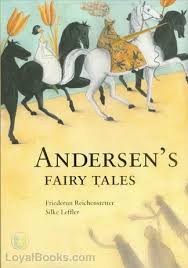The Dream of Little Tuk
byThe Dream of Little Tuk opens with a humble scene, where a young boy finds himself caught between responsibility and the need for learning. Caring for his little sister while preparing for school, Tuk is shown to be kindhearted and dutiful, despite lacking basic comforts like candlelight. His commitment to both family and schoolwork becomes evident when he gives up his own time to help an old washerwoman, not for reward, but from simple goodness. As sleep overtakes him, so does a dream, born not from laziness but from exhaustion mixed with imagination. That dream turns into a fantastic voyage where geography becomes more than names—it turns into people, cities, and stories. This tale begins in reality, but quickly becomes a celebration of inner richness—how a poor child with no candle can still shine light through wonder and kindness.
As Tuk dreams, he meets various whimsical characters representing Denmark’s towns and landmarks, including animals who speak and historical figures who guide. From a proud bird in Prastoe to the ruins of ancient castles in Bordingborg, Tuk is given lessons far beyond his textbook. Each location introduces more than geography; they bring with them values, memories, and a sense of identity tied to culture and place. The dream’s structure mirrors the country’s own diversity, making history come alive in a personal, magical way. These vibrant interactions not only make learning fun but also show how knowledge can be passed on creatively. His mind, though young and weary, acts as fertile ground for both dreams and learning to grow together.
The story does more than entertain; it subtly highlights how hardship can coexist with great imagination. Even though Tuk lacks resources, his inner world is vast and enriched through kindness and curiosity. A washerwoman’s prayer for him, a gesture of thanks, becomes the catalyst for the dream journey—showing how gratitude and goodness return in surprising forms. Tuk doesn’t study in the way most expect; instead, he absorbs his lesson through experience in the dream world. By morning, he awakens not just with answers, but with insight, having walked through a Denmark far more alive than any textbook could offer. The tale reminds readers that empathy and wonder can become tools for both academic and emotional growth.
The final moments of the dream bring a touch of humor and reflection, with the transformation of a character into a frog—subtly reminding readers of the flexibility needed in life. Learning isn’t always straightforward; it shifts, adapts, and sometimes hops in unexpected directions. Tuk’s journey shows that education is not just in repetition or memorization, but in being open to what the world has to teach, in whatever form it may come. The story is both a lesson and a lullaby—a way of saying that even those with the least can imagine the most. What Tuk gains isn’t just knowledge of cities or kings; he learns the heart of his country, the strength of his dreams, and the joy that comes from doing right by others.
In a broader sense, Tuk’s story mirrors how children often learn best: not by pressure, but by connecting emotionally to the world around them. His kindness sets his dream in motion, and his curiosity carries him through it. Andersen uses this tale to highlight how storytelling can be an educational bridge—making facts come alive through feeling. Though Tuk lives in modest means, his character shines through dedication, warmth, and resilience. That is what makes his story unforgettable. Through this journey, readers of all ages are reminded that learning can take many forms—and sometimes, the best lessons are those taught not in classrooms, but in dreams guided by the heart.

